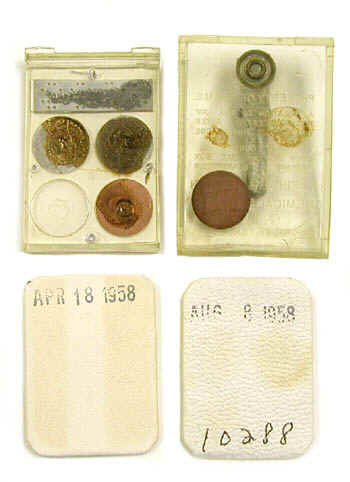Oak Ridge National Laboratory Film Badge (ca. 1953-1958)

This badge, designed at built at Oak Ridge National Laboratory (ORNL), was a combination dosimeter and identification badge. In this case, the badge belonged to John Auxier who would later replace KZ Morgan as head of ORNL’s Health Physics program. The estimated date (1953-1957) is based on several factors. First, the films in the dosimeter are stamped with the date 1958. Second, ORNL switched to a new style of badge in 1958. Third, this badge is described in some detail in an ORNL document dated January 1, 1954. Finally, the badge could not have been produced much earlier than 1954 because it employs multiple filters, a feature that was not routinely used prior to the early 1950s.
Although not the case with the example shown here, the front of the badge would normally have a picture of the individual to whom the badge was assigned.
An image of the employee's ID number was created on the developed film via a perforated lead foil running across the top portion of the front of the badge.

To help determine the effective energy of the gamma rays and X-rays, the badge employed three circular filters: lead, cadmium and copper. The cadmium and copper served a dual role: in the event of a neutron exposure, the radioactivity induced in the cadmium and copper could be used to estimate the neutron dose. As can be seen in the photo to the right, the cadmium and lead filters have detached from the back portion of the badge.
The badge accommodated two film packs which could be inserted or removed via two slots along the sides of the case. One film packet, containing NTA film, was used to measure the worker's neutron dose. It was changed out weekly if the employee was working around neutron sources. If that was not the case, the film was changed out quarterly or semiannually.
The other film packet, used to measure gamma ray and X-ray exposures, was DuPont type 553. The latter included three film emulsions: 502, 510 and 606. The use of three emulsions meant that it was capable of measuring exposures over a particularly broad range.
Size: 1” x 2 3/16” x Ľ”
Weight: ca. 21 grams
Material: Tenite-2 plastic with metal alligator clip
References
- Davis , D.M., Gupton, E.D. and Hart, J.C. Applied Health Physics Radiation Survey Instrumentation. ORNL-332 (1st Rev.), January 1, 1954.
- Gupton, E.D., Davis , D.M. and Hart, J.C. Criticality Accident Application of the Oak Ridge National Laboratory Badge Dosimeter. Health Physics Vol. 5:57-62; 1961.
